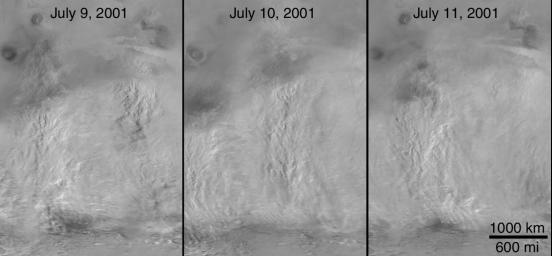
|
The 2001 Great Dust Storms - Daedalia/Claritas/Syria Dust Plumes
- Click the image above for a larger view
- Full-Res JPEG (1595 x 740) (120.8 kB)
- Full-Res TIFF (1595 x 740) (743.2 kB)
Caption:
Although dust storms occur year-round on Mars, they often occur in greater numbers during certain seasons. In particular, it has long been known from Earth-based telescopic observations that the largest, global dust events(those that enshroud the entire planet) occur during the southern spring and summer. As the Mars Global Surveyor (MGS) mission began to monitor this period for the second time, particular attention was paid to local and regional dust storms in anticipation of capturing--for the first time--high spatial-and time-resolution observations of the start of a "global" storm.
Throughout the month of June 2001, the MGS Mars Orbiter Camera (MOC)routinely accumulated low resolution (7.5 km/pixel) global maps of Marson an orbit-by-orbit basis. A moderately large number of local dust storms were noted, especially along the retreating margin of the seasonal south polar CO 2 frost cap and around the large and deep Hellas impact basin that dominates the southern, eastern highlands. On June 21, an otherwise undistinguished small dust storm surged into the basin from the southwest. When viewed 24 hours later, the storm had circulated clockwise about 1/3 of the circumference of Hellas, indicating relatively high winds. For the next three days, this storm brewed north of Hellas and east towards Hesperia, but didn't cross the equator (see PIA03170 ). Then, sometime between 2 PM local Mars time on June 25 and 2 PM local Mars time on June 26, the storm exploded north across the equator, and in less than 24 hours thereafter, dust was being raised from separate locations in Arabia, Nilosyrtis, and Hesperia, thousands of kilometers away from Hellas. This was the start of the long-anticipated global dust event.
Over the following week, dust injected high into the stratosphere during the initial Hellas and Hesperia storms drifted eastward, carried by the prevailing south circumpolar jet stream. Beneath this "veil" of dust, an intense wind front moved across Mars, setting up conditions for many other local and regional dust storms. By July 4, a large regional storm was raging between Daedalia Planitia south of the Tharsis volcanoes and Syria Planum (just south of Labyrinthus Noctis, see PIA03171 ). Another storm was raising plumes of dust in north central Noachis/southwestern Meridiani. Plumes were rising in Hesperia but not Hellas.
Throughout July and August, MOC observations revealed a general pattern of regional storm centers beneath an ever-spreading veil of stratospheric dust. The Daedalia/Claritas/Syria storm created dust plumes on over 90 consecutive days .
Previous views and perceptions of global dust events had noted regional brightenings within the overall pall of what was called a "global duststorm." From our new observations, we know that at least this global dust "storm" was really a set of storms, somehow triggered to occur at the same time. We also know that dust was not raised from everywhere on the surface during this global event, but rather from discrete, long-lived centers of activity. We saw, for the first time, rapid, cross-equatorial flow of dust-raising winds.
Background Info:
Malin Space Science Systems and the California Institute of Technology built the MOC using spare hardware from the Mars Observer mission. MSSS operates the camera from its facilities in San Diego, CA. The Jet Propulsion Laboratory's Mars Surveyor Operations Project operates the Mars Global Surveyor spacecraft with its industrial partner, Lockheed Martin Astronautics, from facilities in Pasadena, CA and Denver, CO.
Cataloging Keywords:
| Name | Value | Additional Values |
|---|---|---|
| Target | Mars | |
| System | ||
| Target Type | Planet | |
| Mission | Mars Global Surveyor (MGS) | |
| Instrument Host | Mars Global Surveyor | |
| Host Type | Orbiter | |
| Instrument | Mars Orbiter Camera (MOC) | |
| Detector | ||
| Extra Keywords | Atmosphere, Dust, Grayscale, Impact, Plume, Storm, Volcano | |
| Acquisition Date | ||
| Release Date | 2001-10-13 | |
| Date in Caption | ||
| Image Credit | NASA/JPL/MSSS | |
| Source | photojournal.jpl.nasa.gov/catalog/PIA03172 | |
| Identifier | PIA03172 | |
